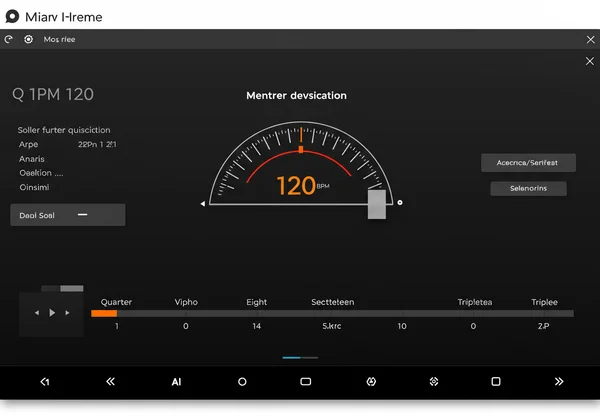Free Metronome Online: Essential Practice for Drummers' Timing
Drummers seeking that perfect pocket, solid groove, and razor-sharp timing often find themselves at a plateau without a consistent practice partner. A high-quality metronome for drums is that partner. But how can a metronome improve my playing? It’s more than just a click; it’s an objective anchor that builds your internal clock from the ground up. This guide will help you move beyond basic beat-keeping, showing how tools like our online metronome can significantly improve your precision, speed, and rhythmic understanding.

Why Every Drummer Needs an Online Metronome for Timing
Before we dive into exercises, it's crucial to understand why a metronome is the most important tool in a drummer's arsenal. It's not a crutch to be discarded but a diagnostic tool to be mastered. A reliable, free metronome provides the honest feedback necessary for true rhythmic growth, exposing subtle flaws in your playing that your ears might otherwise miss.
Beyond Basic Beatkeeping: Developing Your Internal Clock
The ultimate goal isn't to depend on a click forever; it's to internalize it. Consistent practice with a metronome calibrates your brain and body, developing your internal clock. Think of it as a personal trainer for your sense of rhythm. Over time, you'll feel the pulse even when the click isn't there, allowing you to play with confidence and authority in any musical situation. Your groove becomes unshakable because its foundation is built on rhythmic precision.

How a Metronome Exposes & Fixes Timing Inconsistencies
Do you rush your fills? Do you drag the tempo during a slow ballad? A metronome has no opinion and offers no mercy—it simply reveals the truth. These timing inconsistencies are what separate amateur players from professionals. By practicing with a steady click, you are forced to confront these tendencies head-on. You learn to place each note—from the kick drum to the cymbal crash—exactly where it belongs, achieving the groove stability that defines great drumming.
Foundational Rhythm Practice for Drummers
Mastery begins with the basics. These foundational exercises are designed to build a rock-solid rhythmic base using a simple rhythm practice for drummers approach. The key is to start slow, focus on consistency, and be patient with your progress.
Setting Your Online Metronome BPM for Effective Warm-ups
Every great practice session starts with a solid warm-up. Before you attempt anything complex, set your online metronome BPM to a slow, comfortable tempo, like 60-80 BPM. On our platform, you can easily slide the BPM counter or type in the exact number. Spend 5-10 minutes playing simple single strokes on the snare or practice pad, ensuring every single hit lands perfectly with the click. This simple exercise builds muscle memory and focuses your mind for the work ahead.
Mastering Basic Subdivisions (Eighths, Sixteenths, Triplets)
A groove is built from subdivisions—the notes between the main beats. Mastering basic subdivisions is essential for a versatile rhythmic vocabulary. Using a flexible time signature metronome, you can systematically work on:
- Quarter Notes: One note per click.
- Eighth Notes: Two notes per click ("1-and-2-and").
- Sixteenth Notes: Four notes per click ("1-e-and-a-2-e-and-a").
- Triplets: Three notes per click ("1-trip-let-2-trip-let").
Our tool lets you visually select these subdivisions, providing both an audio and visual cue to guide you. Practice switching between them without losing the pulse.

Practicing Consistent Tempo Across Different Drumming Styles
Maintaining a consistent tempo is a universal skill, but it feels different across genres. A rock backbeat, a jazz swing pattern, and a funk groove all require perfect timing. Use the metronome as your anchor while you practice different styles. Can you play a simple rock beat for five minutes without speeding up? Can you maintain a relaxed swing feel without dragging? This is how you develop the versatility to play any style with authority.
Advanced Drumming Techniques with Your Metronome
Once you've solidified your foundation, it's time to push your limits. These advanced drumming techniques will challenge your coordination, precision, and musicality, turning the metronome into a tool for creative exploration.
Sharpening Drum Fills & Transitions with Precision
A sloppy drum fill can ruin an entire song. The key to clean fills is ensuring they resolve perfectly on the "one" of the next measure. Practice sharpening drum fills by setting your metronome and playing a simple groove for three bars, followed by a one-bar fill. Your primary goal is to have your kick and crash land exactly with the click on beat one of the following bar, creating seamless transitions.
Unlocking Polyrhythms for Drummers with Subdivision Controls
Ready to expand your rhythmic mind? Unlocking polyrhythms involves playing two different rhythmic patterns simultaneously. For example, playing quarter-note triplets with your hands while your feet play straight quarter notes. This can be confusing, but a metronome with clear subdivision controls simplifies the process. Set the click to represent the main pulse and use the advanced subdivision options on our rhythm practice tool to internalize these complex rhythms one layer at a time.
The "Click-Out" Method for Building Rhythmic Independence
This exercise is the ultimate test of your internal clock. The goal is building rhythmic independence by forcing you to keep time without the click. Set the metronome to play for one measure and be silent for the next. During the silent bar, you must continue playing in perfect time, aiming to land precisely on the "one" when the click returns. This powerfully reinforces your internal rhythm and builds unshakable confidence.

Integrating Your Online Metronome Into Daily Drum Routine
Consistency is everything. Making your online drum metronome a non-negotiable part of your daily practice will yield exponential results. It should feel as essential as your sticks and drum kit.
Leveraging the Built-in Timer for Focused Practice Sessions
Mindless practice is wasted time. Use the built-in timer on our metronome tool to create focused practice sessions. For example, set a timer for 15 minutes dedicated solely to sixteenth-note exercises at 100 BPM. This structured approach prevents burnout and ensures every minute you spend practicing is productive and goal-oriented.
Recording & Analyzing Your Metronome Practice
For the most honest feedback, try analyzing your metronome practice. Use your phone to record yourself playing along with the click. When you listen back, are you consistently ahead of, behind, or right on the beat? This simple act of self-assessment is incredibly powerful and will reveal timing habits you never knew you had, allowing you to make targeted improvements.
Elevate Your Drumming: Build Rhythmic Mastery Starting Today
From developing your internal clock to mastering complex polyrhythms, the metronome is an essential guide on your path to rhythmic excellence. It’s about more than just playing in time; it’s about mastering your timing. By integrating these foundational and advanced exercises into your routine, the simple click becomes a powerful ally for growth.
The journey to becoming a stronger drummer begins with consistent, perfectly-timed practice. Start practicing with our online metronome today and experience the difference in your playing.
Frequently Asked Questions for Drummers and Metronomes
How can an online metronome improve my drum timing?
An online metronome provides an objective, unwavering reference point for the beat. It exposes whether you tend to speed up (rush) or slow down (drag), forcing you to develop a more precise and stable internal clock. Consistent practice with this tool builds the muscle memory and mental focus needed for professional-level timing.
What's a good starting BPM for drum practice?
A great starting BPM for any new exercise is between 60 and 80 BPM. This slow tempo allows you to focus on the accuracy and feel of each note without feeling rushed. Once you can play an exercise perfectly and relaxed at a slow speed, you can gradually increase the tempo using the BPM counter.
How do drummers use metronome subdivisions?
Drummers use subdivisions to practice the accuracy of notes played between the main beats (e.g., eighths, sixteenths, triplets). A good online metronome allows you to hear these subdivisions, helping you lock in complex patterns like shuffles, funk grooves, and fast fills. It ensures every note has its proper place within the beat.
Can I practice drum fills with a metronome?
Absolutely. Practicing fills with a metronome is essential for ensuring they start and end on time. It trains you to execute a fill without losing the underlying pulse, allowing you to land perfectly on beat "one" of the following measure, which is crucial for keeping the band together.
What is the "click-out" method for drummers?
The "click-out" method is an advanced exercise where the metronome plays for a set number of bars and then is silent for the same number. During the silent bars, the drummer must continue playing and maintain perfect time, testing their internal clock. It's a powerful way to build confidence and rhythmic independence from the click.